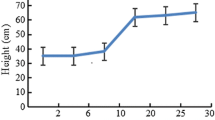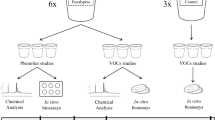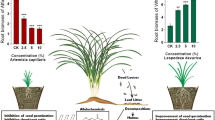Abstract
Allelopathic effects of Eucalyptus camaldulensis Dehnh. were confirmed in Petri dish and pot experiments in our previous studies. However, the degree to which such effects under controlled experiments exist in more complex ecological settings remains to be tested. Thus, the present study was carried out by incorporating different proportions of ground litter of E. camaldulensis in soil. The growth of three agricultural crops: falen (Vigna unguiculata (L.) Walp.), chickpea (Cicer arietinum L.), and arhor (Cajanus cajan (L.) Millsp.), and two tree species, kala koroi (Albizia procera (Roxb.) Benth.) and ipil ipil (Leucaena leucocephala (Lam.) de Wit) were tested. There were inhibitory effects of leaf litter on germination, shoot and root growth, leaf number, and collar diameter as well as a reduction of nodulation by legume crops (25–80% reduction). The extent of the effects was dependent on the proportion of leaf litter, the species and the type of traits. In contrast to shoot growth, the effect on root growth was more severe. No effect on germination was found with the agriculture crops while the two tree species showed reduced germination. The effect was greater in the presence of higher proportions of leaf litter mixed in soil while in some cases lower proportions stimulated growth. Not all species were suppressed; A. procera, C. cajan, V. unguiculata showed compatible growth while C. arietinum and L. leucocephala were found incompatible. This study provides evidence that E. camaldulensis has allelopathic potential under field conditions and a careful selection of associated crops in agroforestry systems is highly recommended.
Similar content being viewed by others
References
Abhilasha D, Quintana N, Vivanco J, Joshi J (2008) Do allelopathic compounds in invasive Solidago canadensis s.l. restrain the native European flora? J Ecol 96:993–1001
Adams MA, Attiwill PM (1986) Nutrient cycling and nitrogen mineralization in eucalypt forests of south-eastern Australia. I. Nutrient cycling and nitrogen turnover. Pl Soil 92:319–339
Ahmed FU, Akhter S (1995) Problems and prospects of Eucalyptus. In: Amin SMR, Ali MO, Fattah MIM (eds.), Eucalyptus in Bangladesh, Proceedings of the National Seminar held at Bangladesh Agricultural Research Council, Dhaka on April 16.1994, pp 42–53
Ahmed R, Uddin MB, Hossain MK (2004) Allelopathic effects of leaf extracts of Eucalyptus camaldulensis Dehn. on agricultural crops. Bangladesh. J Bot 33(2):79–84
Ahmed R, Redowan M, Uddin MS, Hossain MK (2007a) A pot experiment to evaluate the allelopathic potential of leaf extracts of Eucalyptus camaldulensis on five common agricultural crops. Int J Sustain Agric Technol 5(3):280–285
Ahmed R, Redowan M, Uddin MS, Hossain MK (2007b) Eucalyptus as a agroforestry component in the homestead and agricultural field of Sitakunda, Bangladesh. Int J Sustain Agric Technol 3(3):46–51
Ahmed R, Uddin MB, Khan MS, Mukul SA, Hossain MK (2007c) Allelopathic effects of Lantana camara L. on germination and growth behavior of some agricultural crops. J For Res 18(4):301–304
Ahmed R, Hoque ATMR, Hossain MK (2008) Allelopathic effects of leaf litters of Eucalyptus camaldulensis on some forest and agricultural crops. J For Res 19(1):19–24
Ameen M (1999) Development of guiding principles for the prevention of impacts of alien species. Paper presented at a consultative workshop in advance of the 4th Meeting of SBSTTA to the CBD, organized by IUCN Bangladesh at Dhaka on 25 May 1999
Amin SMR, Ali MO, Fattah MIM. (eds.) (1995) Eucalypts in Bangladesh. Proceedings of a seminar held at the Bangladesh Agricultural Research Council, Dhaka on April 6, 1994. pp 73
Ashrafi Z, Mashhadi HR, Sadeghi S, Alizade HM (2008) Effects allelopathical of sunflower (Helianthus annuus) on germination and growth of wild varley (Hordeum spontaneum). J Agric Technol 4(1):219–229
Attiwill PM (1979) Nutrient cycling in a Eucalyptus obliqua (L’Herit.) forest. III. Growth, biomass, and net primary production. Aust J Bot 27(4):439–458
Ballester A, Vieitez AM, Vieitez E (1982) Allelopathic potential of Erica vegans, Calluna vulgaris and Daboecia cantabrica. J Chem Ecol 8:851–857
Bargali K, Bargali SS (2000a) Nutrient utilisation efficiencies of two central Himalayan tree species. J Trop For Sci 12(3):450–458
Bargali K, Bargali SS (2000b) Diversity and biomass of the understory vegetation in an age series of Eucalyptus tereticornis plantation. Int J Ecol Environ Sci 26:173–181
Bargali SS, Singh RP, Singh SP (1992a) Structure and function of an age series of eucalypt plantations in Central Himalaya, II. Nutrient dynamics. Ann Bot 69(5):413–421
Bargali SS, Singh SP, Singh RP (1992b) Structure and function of an age series of eucalypt plantations in Central Himalaya. I. Dry matter dynamics. Ann Bot 69(5):405–411
Bargali SS, Singh SP, Singh RP (1993) Patterns of weight loss and nutrient release from decomposing leaf litter in an age series of eucalypt plantations. Soil Biol Biochem 25:1731–1738
Bradstock R (1981) Biomass in an age series of Eucalyptus grandis plantations. Aust J For Res II:111–127
Catherine F, Benjamin L, Bruno V, Jean-Philippe M, Christine R, Stéphane G, Sylvie D, Anne BM (2006) Potential allelopathic effect of Pinus halepensis in the secondary succession: an experimental approach. Chemoecology 16:97–105
Catherine F, Sébastien V, Jean-Philippe M, Bruno V, Elena O, Sylvie D, Anne BM (2008) Regeneration failure of Pinus halepensis Mill: the role of autotoxicity and some abiotic environmental parameters. For Ecol Manag 255:2928–2936
Courtney KJ, Ward BB, Langenheim JH (1991) The effect of coastal redwood monoterpenes on Nitrosomonas europaea. Am J Bot 78:144–145
Davidson J (1985) Ecological and social aspects of eucalypts when used as exotics. In: J. Davidson and S. Das (eds.), Eucalypts in Bangladesh—a Review. Silviculture Bulletin No. 6. Chittagong. Bangladesh Forest Research Institute, pp 13–49
Davidson J, Das S (1985) Eucalypts in Bangladesh—A review. Bull. 6, Silv. Res. Div. Bangladesh Forest Research Institute, Chittagong, Bangladesh. Pp. 246
Del Fabbro C, Gusewell S, Prati D (2014) Allelopathic effects of three plant invaders on germination of native species: a field study. Biol Invasions 16:1035–1042
Djurdjević L, Popović Z, Mitrović M, Pavlović P, Jarić S, Oberan L, Gajić G (2008) Dynamics of bioavailable rhizosphere soil phenolics and photosynthesis of Arum maculatum L. in a lime—beech forest. Flora 203:590–601
Einhelling FA (1996) Interactions involving allelopathy in cropping systems. Agron J 88:886–893
Ens EJ, French K, Bremner JB (2009) Evidence for allelopathy as a mechanism of community composition change by an invasive exotic shrub, Chrysanthemoides monilifera spp. Rotundata. Pl Soil 316:125–137
Haque SMS (2013) Geology, soil science and forest soils. Degradation of upland watershed in Bangladesh project funded by USDA, Institute of Forestry and Environmental Science, p 332
Hasanuzzaman M, Hossain M, Saroar M (2004) Diversity and Preference of agricultural crops in the cropland agroforests of southwestern Bangladesh. Int J Agric Crop Sci 7(7):364–372
Hassan MM (1994) Prospects of Eucalypts in Bangladesh. Bangladesh J For Sci 23(1):12–19
Hong NH, Xuan TD, Eiji T, Khanh TD (2004) Paddy weed control by higher plants from Southeast Asia. Crop Prot 23:255–261
Hoque ATM, Ahmed R, Uddin MB, Hossain MK (2003a) Allelopathic effect of different concentration of water extracts of Acacia auriculiformis on some initial growth parameters of five common agricultural crops. Pak J Agron 2(22):92–100
Hoque ATMR, Uddin MB, Ahmed R, Hossain MK (2003b) Suppressive effects of aqueous extracts of Azadirachta indica leaf on some initial growth parameters of six common agricultural crops. Asian J Pl Sci 2(10):738–742
Hossain MK, Hoque ATMR (2013) Eucalyptus Dilemma in Bangladesh. Institute of Forestry and Environmental Sciences, University of Chittagong, Chittagong, p 148
Inderjit (2005) Soil microorganisms: an important determinant of allelopathic activity. Pl Soil 274:227–236
Jandová K, Dostá P, Cajtham T (2015) Searching for Heracleum mantegazzianum allelopathy in vitro and in a garden experiment. Biol Invasions 17:987–1003
Jones JM, Richards BN (1977) Effect of reforestation on turnover of 15N labelled nitrate and ammonium in relation to changes in soil micro-flora. Soil Biol Biochem 9:383–392
Kaur H, Kaur R, Kaur S, Baldwin IT, Inderjit (2009) Taking ecological function seriously: soil microbial communities can obviate allelopathic effects of released metabolites. PLoS ONE 4:e4700
Keeley JE (1988) Allelopathy. Ecology 69:292–293
Khan MA, Khitran TA, Baloch MS, Suiemani MZ (1999) Allelo- pathic effect of eucalyptus on soil characteristics and growth of maize. Pak J Biol Sci 2(1):390–393
Lankau R (2010) Soil microbial communities alter allelopathic competition between Alliaria petiolata and a native species. Biol Invasions 12:2059–2068
May FE, Ash JE (1990) An assessment of the allelopathic potential of eucalyptus. Aust J Bot 38:245–254
Nektarios PA, Economou G, Avgoulas C (2005) Allelopathic effects of Pinus halepensis needles on turfgrasses and biosensor plants. HortScience 40(1):246–250
Nishimura H, Kaku K, Nakamura T, Fukazawa Y, Mizutani J (1982) Allelopathic Substances, (±)-p-Menthane-3,8-diols Iso- lated from Eucalyptus citriodora Hook. Agric Biol Chem 46:319–320
Powell KI, Chase JM, Knight TM (2013) Invasive plants have scale-dependent effects on diversity by altering species area relationships. Science 339:316–318
Reigosa MJ, Gonzalez L, Souto XC, Pastoriza JE (2000) Allelopathy in forest ecosystems. In: Tauro P (ed) Allelopathy in ecological agriculture and forestry. Kluwer, Dordrecht, pp 183–193
Rice EL (1984) Allelopathy, 2nd edn. Academic Press, Orlando, p 422
Shiva V, Bandyopadhyay J (1983) Eucalyptus—a disastrous tree in India. The Ecologist 13(5):184187
Si CC, Liu XY, Wang CY, Wang L, Dai ZC, Qi SS, Du DL (2013) Different degrees of plant invasion significantly affect the richness of the soil fungal community. PLoS ONE 8:e85490
Stowe LG (1979) Allelopathy and its influence on the distribution of plants in an Illinois old-field. J Ecol 67:1065–1085. doi:10.2307/2259228
Sun ZK, He WM (2010) Evidence for enhanced mutualism hypothesis: Solidago canadensis plants from regular soils perform better. PLoS ONE 5:e15418
Surendra MP, Pota KB (1978) On the allelopathic potentials of root exudates from different ages of Celosia argenta Linn. Natl Acad Sci Lett 1(2):56–58
Uddin MB, Ahmed R, Mukul SA, Hossain MK (2007) Inhibitory effects of Albizia lebbeck (L.) Benth. leaf extracts on germination and growth behavior of some popular agricultural crops. J For Res 18(2):128–132
Ward BB, Courtney KJ, Langenheim JH (1997) Inhibition of Nitrosomonas europaea by monoterpenes from coastal redwood (Sequoia sempervirens) in whole cell studies. J Chem Ecol 23(11):2583–2598
White CS (1986) Volatile and water—soluable inhibitors of nitrogen mineralization and nitrification in a ponderosa pine ecosystem. Biol Fertil Soils 2:97–104
White CS (1991) The role of monoterpenes in soil nitrogen cycling processes in ponderosa pine. Biogeochemistry 12:43–68
Wood SE (1996) Loss of foliar monoterpenes from Umbellularia californica leaf litter and their influence on nitrification potential in soil beneath the trees. PhD dissertation. University of California, Santa Cruz, p 151
Yang RY, Mei LX, Tang JJ, Chen X (2007) Allelopathic effects of invasive Solidago canadensis L. on germination and root growth of native Chinese plants. Allelopath J 19:241–248
Yuan YG, Wang B, Zhang SS, Tang JJ, Tu C, Hu SJ, Yong JWH, Chen X (2013) Enhanced allelopathy and competitive ability of invasive plant Solidago canadensis in its introduced range. J Pl Ecol 6:253–263
Zhang JH, Mao ZQ, Wang LQ, Shu HR (2007) Bioassay and identification of root exudates of three fruit tree species. J Integr Pl Biol 49:257–261
Zhang D, Zhang J, Yang W, Wu F (2010) Potential allelopathic effect of Eucalyptus grandis across a range of plantation ages. Ecol Res 25:13–23
Acknowledgements
The authors gratefully acknowledge the comments and valuable suggestions of anonymous reviewers to improve the quality of the article. We wish to thank Mr. Abdur Rahman, the gardener of Nursery at the Institute of Forestry and Environmental Sciences, Chittagong University for his help in conducting the experiments.
Author information
Authors and Affiliations
Corresponding author
Additional information
The online version is available at http://www.springerlink.com
Corresponding editor: Tao Xu.
Rights and permissions
About this article
Cite this article
Ahmed, R., Alam, M.S., Ahmed, F.U. et al. Assaying the allelopathic effects of Eucalyptus camaldulensis in a nursery bed incorporated with leaf litter. J. For. Res. 29, 593–599 (2018). https://doi.org/10.1007/s11676-017-0450-3
Received:
Accepted:
Published:
Issue Date:
DOI: https://doi.org/10.1007/s11676-017-0450-3




